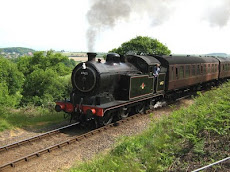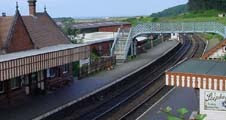I guess one can't have perfect weather every day while one is away on holiday, can we, eh!? And today was one of those dreary, bleary, windy, rainy, wet days. The wind was howling up, under, and through the shingles all night. The white caps were on the waves as I looked out the window this morning. It was raining just short of cats and dogs. Visibility out into the North Sea was not good and not looking to get any better. 
I had planned to go to Letheringsett and make my piglrimmage up to Stephen Moore's pit hole. But, as that would require a lot of walking in the rain, I decided to go to Plan B (or by this time is it Plan G, H, or I?).
Public transit, whether by train or bus, is incredible in England. During the week, trains every hour and the half hour to every major city, town, or hamlet. And those not served by train (and even those that are served by train), are connected by buses that run every hour and half hour. Except on holidays when they run every two hours. And today was the May bank holiday.
I had previously checked the Coast Hopper bus time tables in case of an eventuality like today and hiked up to the NNR trains station to catch the 10:18 bus that would take me along the coast to King's Lynn - or so the timetable and website said. The gameplan was to simply sit on the bus and take in the sights as we travelled along the coast between Sheringham westward to King's Lynn, tracing the route backwards to Cromer, and returning back to Sheringham.
Sheringham to Holt (5 miles) wasn't too bad as I could see the coast from a distance. However, from Holt to King's Lynn, the bus went deeper south away from the coast and into the heart of the Norfolk Countryside which, as you can see from the map above, took a shortcut across country well away from the coast.
Notwithstanding the distance away from the coast, I quickly remembered the names of the towns we were passing through. Once-upon-a-time, they were railway towns that had long since seen the tracks disappear. I had been reading books on some of these railway lines so I had a rough idea of where the lines might be. Being well-used to locating long-abandoned railway lines, I soon began to pick up the remaining pieces of roadbed, cuts, and fills that I had located on the ordinance survey maps that I had purchased the weeks before. Only problem was I hadn't brought them along with me on this trip.
As the bus travelled through the countryside, I got a good appreciation of the little towns and villages that we were passing through.
The crops in the fields were doing well. While crops in Eastern Ontario are rotated through cycles of corn, soybean, wheat or oats, the crops in Norfolk are rotated through sugar beets, soybeans, and malt. While all of the sweeteners in prepared foods and soft drinks in North America are made from corn syrup (high fructose corn syrup or HFCS), in England the sweeteners are made from the sugar beet which is grown in large acreages as we grow corn in Eastern Ontario. The major difference is that the fields for the sugar beet are prepared using roto-tillers on the back of the tractors instead of cultivators or discs.
We soon arrived in King's Lynn where the bus had a 30 minute layover before we retraced our route back to Sheringham, on to Cromer, and back to Sheringham.
As it was only 3:00, I decided to hop the train up to the shops at Weybourne to see what the diesel guys were doing. As this was a long weekend, it was a good opportunity for them to work on their locos and see if they could get them running. Of course, who should be there to greet me when I arrived at the station in Sheringham but GWR 0-6-2T #5619.
I talked to the lads in the shops for a bit discussing the merits of 12-cylinder versus 16-cylinder engines, AC vs DC traction motors, the evolution of the diesel locomotive in England, and other techno-gab items that only a true fanatique ferroviaire would comprehend. Allistair's crew said they might get their diesel running later on in the week so that would be an event to watch. I walked up the hill to Weybourne station to catch the next train back to Sheringham. There was #5619 at the end of her day waiting to greet me.
We're off to Norwich and the Norfolk Archives tomorrow to chase down some family roots with Michael and Susan Whelan. Should be interesting to see what we find.





















































